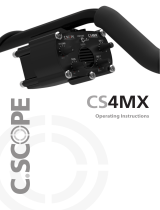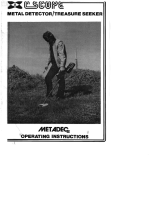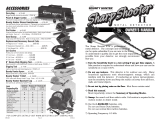Page is loading ...

CS2MX
Operating Instructions

2
1. Control box mounting clip
2. On/O/Sensitivity control
3. Loudspeaker
4. Pin-point push button
5. All-metal/discrimination level control
6. Battery compartment
7. 8 x AA battery holder
8. Headphone socket
9. Battery contacts
10. Control box
11. Hand grip
12. Upper stem
13. Arm support
14. Detector rest
15. Stem lock
16. Lower stem
17. Search-head
18. Search-head xing screw and wing-nut
19. Search-head lead
8
Identifying the Parts
1
10
13
14
12
15
16
17
18
CS2MX
3
1
9
6
7
5
2
4
19
11

3
Overview
The CS2MX is a high performance metal detector operating on the ‘MOTION’
principle. This means that the search-head must be kept moving at a steady sweep
speed to achieve optimum performance.
There is a pin-point function which switches o the motion eect so that the
search-head can be brought to rest over the target signal.
The discrimination system is capable of eliminating signals from a variety of metals
which are likely to be valueless.
The CS2MX is designed to oer high performance whilst being easy to operate.
We wish you good hunting!
Follow these simple steps to start using the CS2MX within minutes:
1. Insert the lower stem into the upper stem (rst press in the spring clip).
2. Twist the locking device so that the stem is locked at the required length.
3. Coil the search-head lead around the stem.
4. Remove the battery compartment cover by loosening the four retaining screws.
5. Fit 8 x AA batteries to the battery holder being careful to observe polarity
and good contact.
6. Rotate the discrimination control to the ‘3’ on the DISC dial.
7. Switch on and rotate the sensitivity control to ‘8’ on the SENS dial.
8. START DETECTING. Metal targets give a sharp audio signal from the loudspeaker.
Signals from small pieces of iron rubbish are ignored. Pressing the pin-point button
means you can stop swinging the search-head from side to side and identify the exact
position of the target.
Rapid start

4
On/O/Sensitivity.
Rotary control switches the detector on/o and adjusts the sensitivity. Ground containing
mineralisation and some beach situations may cause instability or false signals requiring
a reduction of the sensitivity level.
Loudspeaker (and battery condition indicator).
The presence of metal is indicated by a short tone from the loudspeaker. A distinct step
change in the pitch of the audio signal indicates that the batteries should be changed.
Pin-point.
The ‘motion’ aspect of the CS2MX is switched o whilst the pin-point button is
depressed. In pin-point mode the search-head can be held still to determine
the precise target position. Pin-point mode operates in ‘All Metal’, ie. whatever level
of discrimination you have preset will be switched o while the pin-point button is
depressed. This is a useful facility which allows you to trace around the edges of a
signal to identify large pieces of iron. (Note: very large pieces of iron, such as discarded
agricultural machinery and iron stakes tend to give positive signals even when the
detector is set to high discrimination settings). Once the pin point button is released
the detector returns to motion mode.
Discrimination.
Set to ‘ALL METAL’ there is no discrimination, i.e. all metals are detected. Set DISC control
to between ‘1’ and ‘4’ on dial. Signals from most small iron rubbish are ignored, i.e. there is
no audio signal. The discrimination level can be increased to between ‘4’ and ‘10’ so that
the signals from more categories of metal object are ignored.’
(see ‘Notes on Sensitivity, Ground Eect and Discrimination’).
The CS2MX Features and what they do

5
Assembling the CS2MX
The stem lock should be slackened to allow the lower stem to enter the upper stem
section. The spring clip should be pressed in to allow the lower stem to slide into
the upper stem. This spring clip will pop into any of the holes in the upper stem
and rmly x the two stems together. The twist lock will stop any movement in the stems.
The search-head lead may then be wound around the stem as shown in the photograph.
A search-head lead which is not well secured to the stem could move about causing
false signals. Cable ties or tape may be used to hold the lead in position.
Adjust the position of the search-head so that it is parallel to the ground when the user is
in a normal standing position. Tighten the wing-nut on the search-head retaining screw.
Do not over-tighten. Friction of the head lugs against the neoprene washers keeps
the search-head in position. Excessive pressure on these parts should not be necessary.
(If some form of lubricant should ever nd its way onto these washers it will be necessary
to disassemble the parts, wash and dry them before careful reassembly).
Undo the 4 battery compartment retaining screws and take out the battery holder.
Fit eight good quality AA type batteries into the compartments of the battery holder.
Observe polarity of the batteries (the spring contact goes against the at, negative end
of the battery). Roll the batteries in the holder to ensure good contact and replace into
the battery compartment with the contacts on the holder lining up with the contacts
in the compartment. Replace the battery compartment cover being careful to avoid
cross threading the screws. Battery condition is monitored continuously on the CS2MX.
Low battery condition is indicated by a step change in the signal tone to a higher pitch.
Batteries

6
Successful treasure hunting starts
with a well researched site.
Sweep the detector head from side to side with a steady relaxed motion.
Keep the search-head parallel and as close as possible to the ground right across
the arc of the sweep. The use of a search-head cover protects the head from abrasion
damage caused by friction with the ground. Search your chosen site carefully by moving
forward only the width of the search-head at each sweep. Move up and down the search
area in lines so that there is plenty of overlap in the ground you have covered.
Search with the sensitivity set as high as possible according to the ground conditions.
On the majority of inland sites the recommended sensitivity setting is ‘8’ to achieve the
best results. Some types of ground may give rise to false signals and the sensitivity level
should be reduced to a point where operation of the detector becomes stable.
Some detector users prefer to set the sensitivity control at a point where there is no
background tone, sometimes called ‘silent search’.
With the detector set like this it is more noticeable when a target signal occurs.
If the detector is set at maximum sensitivity there will be an audio tone constantly
in the background and a metal target will be registered by a short increase in
the intensity of that tone.
We recommend searching with a low level of discrimination (between ‘1’ and ‘4’).
At this setting the CS2MX will not react to small pieces of iron but will give a positive
audio tone on other metal targets. Increasing the discrimination level will eliminate signals
from a wider range of metal objects which are likely to be rubbish.
(See Notes on Sensitivity, Ground Eect and Discrimination).
When the detector gives a signal, move the search-head to the approximate area where
the signal was heard, press the pin-point button (using your thumb is best) and move
the search-head carefully around. The strongest signal will occur directly below
the centre of the search-head. Dig a neat hole by cutting around the signal position
with a sharp edged trowel and remove a divot of earth which might now contain
the metal object. Run the detector over the area again in pin-point mode to see
if the metal object is still in the hole or in the piece of earth which you have just removed.
Dig some more and sift through the earth until you nd what you are looking for.
Fill in the hole before moving on.
The use of headphones will increase battery life and make it easier to discern
faint signals.
Follow the ‘Country Code’. Do not trespass. Do not touch anything you suspect
might be live ammunition - inform the police.
Do not take your detector on any scheduled historic site. If you nd anything which
looks like it could have historical signicance, report it to your local museum.
Acquaint yourself with any laws relating to the use of metal detectors particularly
if you want to go detecting in countries other than the UK.
Detecting with the CS2MX

7
Detecting with the CS2MX Sensitivity, ground eect & discrimination
CIGARETTE
PACKET
5p COIN
RING
PULL
SCREW
CAP
NAIL
HORSESHOE
MILK
BOTTLE
TOP
IGNORE (NO SOUND) POSITIVE SIGNAL (SOUND)
1 10
Eect of discriminate control position
You will be able to get more performance out of your detector if you understand the relationship
between three aspects of detector operation - sensitivity, ground eect and discrimination.
If you increase the power of a metal detector too much the ground itself is detected and false
signals make the detector dicult to use. The ‘motion’ electronic system of the CS2MX
will ignore many ground eect signals but some types of ground, notably waterlogged
or containing salts or mineralisation require the detector to operate on reduced sensitivity.
The CS2MX can be set to ignore signals from certain categories of metal target. Small iron objects
in the ground are a problem on many farmland sites. These signals can be ignored by setting
the discriminate control to about number ‘2’ on the discriminate dial.
As the control is turned clockwise the signals from more types of metal likely to be worthless can
be eliminated. However, the discriminate control must be used with care because some objects
which could be valuable have similar electrical characteristics to rubbish items as far as the detector
can tell. Higher levels of discrimination also have the eect of reducing the depth of detection.
For these reasons it is best to keep the discrimination setting as low as possible.
The CS2MX is a robust design, however the control box should be treated with similar care
as any electronic product. Dry o any water splashes immediately. The search-head may
be immersed in water although the connector at the other end of the lead should always
be kept dry. Stem and search-head parts should be cleaned and dried at the end of a day’s
detecting. Do not use solvents. If the detector has been used on a beach it will be necessary
to wash sand and salt residue o the stem adjustment mechanism and the search-head
retaining parts using tap water. Remove batteries if the detector is going to be stored
for any length of time. Do not open the controlbox front panel. There are no user serviceable
parts inside and you may invalidate your warranty.
Detector care

Warranty & service
Your CS2MX is guaranteed free of manufacturing defects as conrmed in our written
warranty. Contact us if you have any concerns about the operation of your detector.
The C.SCOPE Customer Service Team really know about metal detectors
and are always ready with good advice and rapid after-sales-service.
C.SCOPE INTERNATIONAL LTD
KINGSNORTH TECHNOLOGY PARK
WOTTON ROAD ASHFORD
KENT TN23 6LN UK
Telephone: +44 (0)1233 629181
Fax: +44 (0)1233 645897
email: [email protected]
www.csmetaldetectors.com
C.SCOPE is an ISO 9001 Accredited Quality Manufacturer.
This equipment conforms to the EMC directive 89/336/EEC.
System performance may be impaired by unusually strong electromagnetic elds.
Waste electrical products should not be disposed of with household waste.
Please recycle where facilities exist.
Check with your local authority or retailer for recycling advice.
(In the UK visit www.recycle-more.co.uk)
Copyright© 2015 C.Scope International Ltd.
C.Scope has a policy of continuous product development and reserves the right to change the
design, specication and labelling without notice. All errors and omissions excepted.
B1089 issue 1
/












